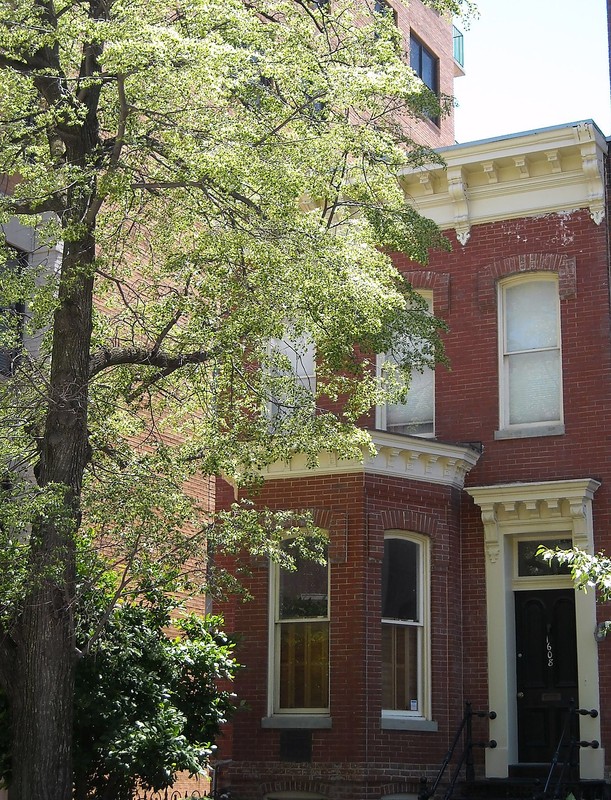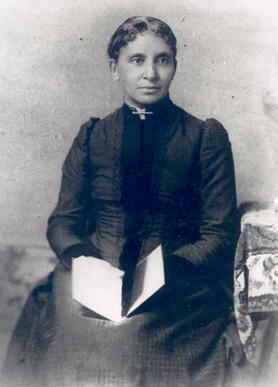Charlotte Forten Grimké House
Introduction
Text-to-speech Audio
Abolitionist, suffragist, writer, poet, and educator Charlotte Forten Grimké (1837-1914) lived in this two-story brick rowhouse from 1881 to 1885. In 1862, she became one of the first free women of African descent to go to the South during the war for the purpose of teaching formerly enslaved people when she moved to St. Helena Island, South Carolina, a sea island that was controlled by the Union early in the war. Grimké is also notable for her diaries, particularly those from the pre-Civil War period and her time on the island. For its association with Grimké, the house is listed on the National Register of Historic Places and is a National Historic Landmark.
Images
Charlotte Forten Grimké lived in this rowhouse from 1881-1885 with her husband, Presbyterian minister Francis James Grimké. She is known for teaching former enslaved people on St. Helena Island, South Carolina during the Civil War, and for her diaries which shed light on the experiences of a free Black woman before and after the Civil War.

Charlotte Forten Grimké (1837-1914)

Backstory and Context
Text-to-speech Audio
Charlotte Forten Grimké was born on August 17, 1837 to a leading abolitionist and wealthy family in Philadelphia. Her paternal grandfather was James Forten, who was born free and became a prosperous sailmaker. He was also an ardent abolitionist, as were his many children including Grimké's father, Robert. Her mother, Mary Virgina Wood, was born into slavery and the daughter of James Cathcart Johnston who owned the Hayes Plantation in Edenton, North Carolina., which is a National Historic Landmark.
As a young woman, Grimké attended the Salem Normal School in Salem, Massachusetts in 1855 (Normal schools trained teachers). After graduating she became the first and only African-American teacher at the all-white Eppes Grammar School in Salem. She began to write around this time and authored a number of poems and articles that were published in the the Liberator, an abolitionist newspaper run by her friend Willian Lloyd Garrison, as well as in the National Anti-Slavery Standard and the Evangelist. In these writings she voiced her support for women's rights and expressed her views against slavery. She also encouraged African-American women to take up abolitionist causes.
Grimké returned to Philadelphia to recover from illness in 1858 and taught there for the next for years. However, she yearned for a more active role to help enslaved people. The opportunity arose after the Union captured St. Helena and the other sea islands in 1861. All of the white residents fled but their former slaves, who numbered around 10,000, remained on the plantations. Most were uneducated and illiterate. To educate them, the federal government implemented a program called the Port Royal Experiment (Port Royal is the name of one of the islands). The first attempt came in March 1862 when a group of 53 white teachers arrived in Port Royal. However, they were unable to gain the trust of the population and the group's attempt failed.
Grimké was more successful but her experience was challenging. She arrived in St. Helena in late October 1862 and taught until 1864. She documented her experiences in her diaries and she sometimes described difficult days. Many of her students spoke Gullah (a language developed by African Americans in the coastal regions of South Carolina and Georgia) and they had a hard time following school routines. It appears she was more comfortable with other white teachers than her students and islanders. Despite these difficulties, she taught around 150 students during her time on the island and also participated in a number of activities in addition to teaching. She was a song leader, storyteller, nurse, and Sunday school teacher. Her students appear to have appreciated her work and left gifts of oranges, figs, and apples. In one diary entry she wrote "It is great a great happiness to teach them..." Grimké was the first and one of the few teachers to record their experiences during the Port Royal Experiment. He work demonstrated the efficacy of the experiment and she developed methods to help teachers relate to and teach former enslaved people.
However, her time on the island took a toll on her health and she became ill, which prompted her to depart in 1864 and return to Philadelphia. In 1878 she married Francis Grimké and they lived in Washington, where Francis was pastor at the Fifteenth Street Presbyterian Church. They had a daughter but she died just a few months after she was born. Grimké worked as an assistant to Francis and continued to publish in newspapers and periodicals. She also served as trustee and secretary of the board at Westborough Insane Hospital in 1889. Her efforts to promote social justice causes for African Americans continued as well. In her later years she was an invalid and passed away in 1914.
Sources
"Charlotte Forten (1837-1914)." PBS. Accessed October 27, 2022. https://www.pbs.org/onlyateacher/charlotte.html.
Graves, Lynne Gomez. "Charlotte Forten Grimké House." National Park Service - National Register of Historic Places Nomination Form. May 11, 1976. https://npgallery.nps.gov/GetAsset/77093518-6ce0-4bd2-888d-d27c3303493d.
"The Port Royal Experiment." Lowcountry Digital History Initiative. Accessed October 27, 2022. http://ldhi.library.cofc.edu/exhibits/show/hidden-voices/continuities-and-changes/enslaved-women-in-the-civilwar/port-royal-experiment.
Wikimedia Commons: https://commons.wikimedia.org/wiki/File:Charlotte_Forten_Grimke_house.JPG
